Ricoh SP 213w, SP 213Nw, SP 211 User Manual
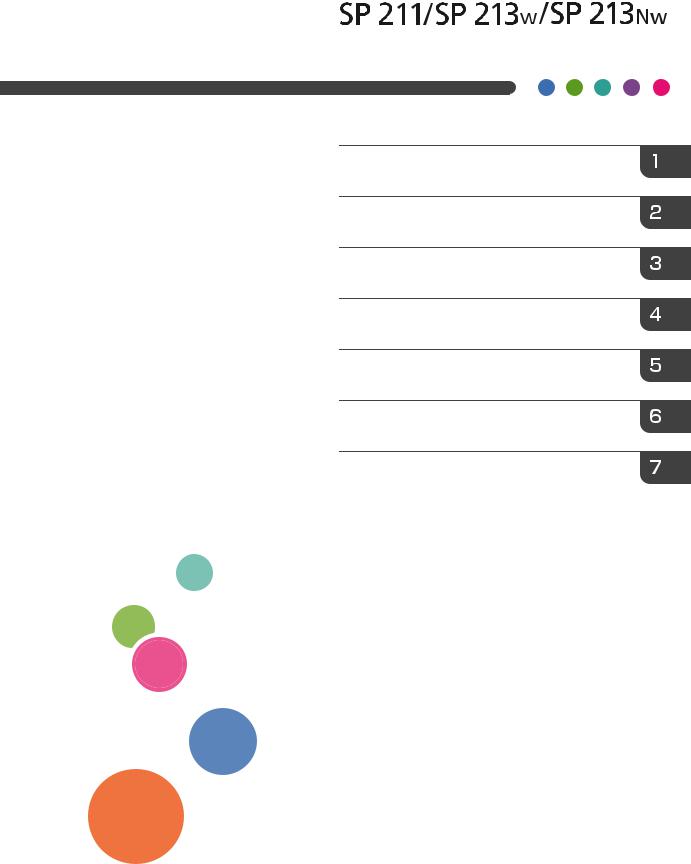
User Guide
Guide to the Machine
Loading Paper
Printing Documents
Configuring the Machine Using Utilities
Maintaining the Machine
Troubleshooting
Appendix
For safe and correct use, be sure to read Safety Information before using the machine.
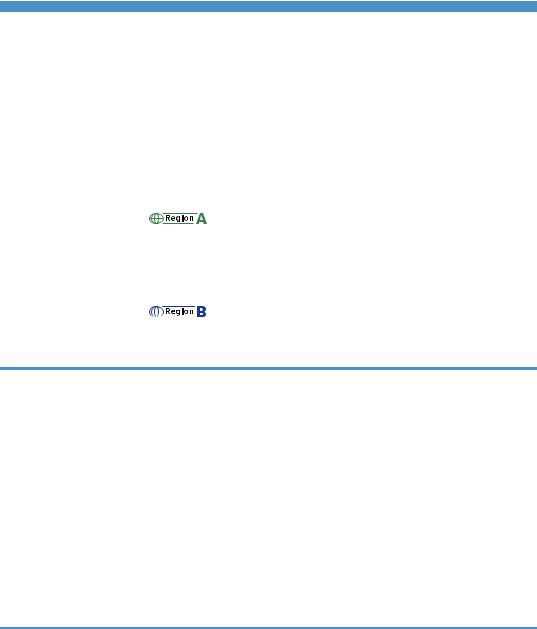
TABLE OF CONTENTS |
|
How to Read This Manual................................................................................................................................. |
4 |
Introduction..................................................................................................................................................... |
4 |
Legal Prohibition............................................................................................................................................. |
4 |
Disclaimer........................................................................................................................................................ |
4 |
About IP Address............................................................................................................................................ |
5 |
Differences in Performance/Functions between Different Models............................................................. |
5 |
Note to Administrator..................................................................................................................................... |
5 |
Model-Specific Information............................................................................................................................... |
6 |
Important Safety Instructions ......................................................................................................... |
7 |
User Information on Electrical & Electronic Equipment............................................................................... |
7 |
Environmental Advice for Users.................................................................................................................... |
7 |
Note for the Battery and/or Accumulator Symbol (For EU countries only).............................................. |
8 |
Important Safety Instructions ......................................................................................................... |
9 |
Notes to Users in the State of California...................................................................................................... |
9 |
1. Guide to the Machine |
|
Guide to Components...................................................................................................................................... |
11 |
Exterior.......................................................................................................................................................... |
11 |
Interior........................................................................................................................................................... |
13 |
About Operation Tools.................................................................................................................................... |
14 |
Installing the Driver and Software................................................................................................................... |
15 |
Network Quick Install.................................................................................................................................. |
15 |
Smart Organizing Monitor.......................................................................................................................... |
15 |
Configuring Network Settings......................................................................................................................... |
16 |
Configuring the IP Address Settings Using the Smart Organizing Monitor............................................ |
16 |
Wireless LAN Setup..................................................................................................................................... |
17 |
2. Loading Paper |
|
Supported Paper.............................................................................................................................................. |
21 |
Non-Recommended Paper Types................................................................................................................... |
23 |
Print Area.......................................................................................................................................................... |
24 |
Loading Paper.................................................................................................................................................. |
25 |
Loading Paper into Tray 1........................................................................................................................... |
25 |
Loading Paper into Bypass Tray................................................................................................................. |
29 |
Specifying Paper Type and Paper Size Using Smart Organizing Monitor............................................. |
30 |
1

3. Printing Documents |
|
Basic Operation............................................................................................................................................... |
33 |
Printing on Both Sides of Sheets.................................................................................................................. |
33 |
Canceling a Print Job................................................................................................................................... |
34 |
4. Configuring the Machine Using Utilities |
|
Using Web Image Monitor............................................................................................................................. |
37 |
Displaying Top Page........................................................................................................................................ |
38 |
Changing the Interface Language.............................................................................................................. |
39 |
Checking the System Information.................................................................................................................... |
40 |
Status Tab..................................................................................................................................................... |
40 |
Counter Tab.................................................................................................................................................. |
40 |
Machine Information Tab............................................................................................................................ |
41 |
Configuring the System Settings...................................................................................................................... |
42 |
Tray Paper Settings Tab............................................................................................................................... |
42 |
Interface Tab................................................................................................................................................ |
43 |
Configuring the Network Settings................................................................................................................... |
44 |
Network Status Tab..................................................................................................................................... |
44 |
IPv6 Configuration Tab............................................................................................................................... |
45 |
Network Application Tab............................................................................................................................ |
45 |
DNS Tab....................................................................................................................................................... |
46 |
Auto E-mail Notification Tab....................................................................................................................... |
47 |
SNMP Tab.................................................................................................................................................... |
48 |
SMTP Tab..................................................................................................................................................... |
49 |
POP3 Tab..................................................................................................................................................... |
49 |
Wireless Tab................................................................................................................................................. |
50 |
Configuring the IPsec Settings......................................................................................................................... |
52 |
IPsec Global Settings Tab........................................................................................................................... |
52 |
IPsec Policy List Tab..................................................................................................................................... |
52 |
Printing Lists/Reports........................................................................................................................................ |
56 |
Configuring the Administrator Settings........................................................................................................... |
57 |
Administrator Tab......................................................................................................................................... |
57 |
Reset Settings Tab........................................................................................................................................ |
57 |
Backup Setting Tab...................................................................................................................................... |
57 |
2
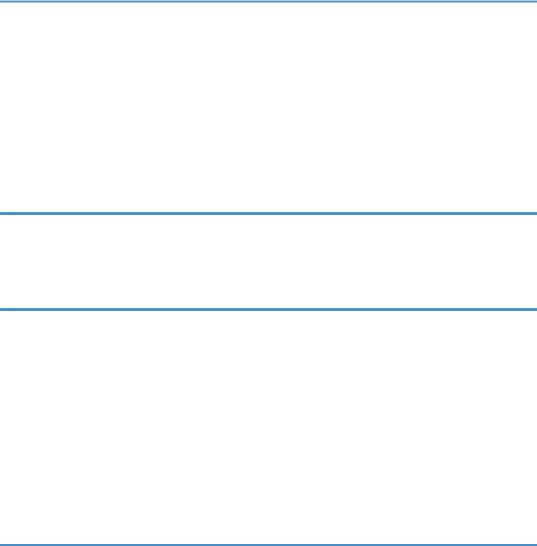
Restore Setting Tab...................................................................................................................................... |
58 |
Help Source File Setting Tab....................................................................................................................... |
59 |
Using Smart Organizing Monitor................................................................................................................... |
60 |
Checking the Status Information................................................................................................................. |
60 |
Configuring the Machine Settings.............................................................................................................. |
61 |
Printing the Configuration Page.................................................................................................................. |
62 |
5. Maintaining the Machine |
|
Replacing the Print Cartridge.......................................................................................................................... |
65 |
Cautions When Cleaning................................................................................................................................ |
67 |
Cleaning the Inside of the Machine................................................................................................................ |
68 |
6. Troubleshooting |
|
Common Problems........................................................................................................................................... |
69 |
Paper Feed Problems....................................................................................................................................... |
70 |
Removing Printing Jams............................................................................................................................... |
71 |
Print Quality Problems...................................................................................................................................... |
77 |
Checking the Condition of the Machine.................................................................................................... |
77 |
Printer Problems................................................................................................................................................ |
78 |
Print Positions Do Not Match Display Positions......................................................................................... |
79 |
Error and Status Indicate on the Control Panel.............................................................................................. |
80 |
Error and Status Messages Appear on Smart Organizing Monitor............................................................ |
81 |
7. Appendix |
|
Notes About the Toner..................................................................................................................................... |
83 |
Moving and Transporting the Machine.......................................................................................................... |
84 |
Disposal........................................................................................................................................................ |
84 |
Where to Inquire.......................................................................................................................................... |
84 |
Consumables.................................................................................................................................................... |
85 |
Print Cartridge.............................................................................................................................................. |
85 |
Specifications of the Machine......................................................................................................................... |
86 |
General Function Specifications................................................................................................................. |
86 |
Printer Function Specifications.................................................................................................................... |
87 |
Trademarks....................................................................................................................................................... |
89 |
INDEX............................................................................................................................................................. |
91 |
3
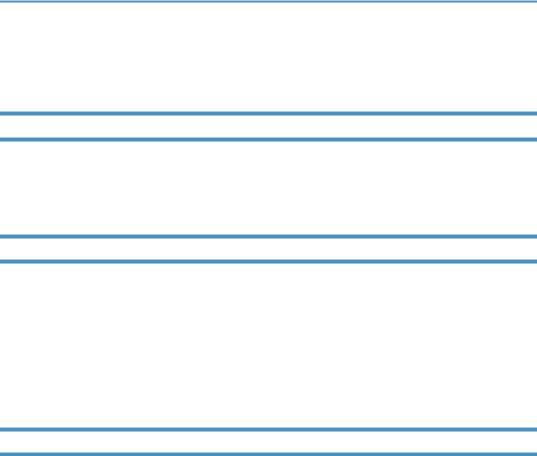
How to Read This Manual
Introduction
This manual contains detailed instructions and notes on the operation and use of this machine. For your safety and benefit, read this manual carefully before using the machine. Keep this manual in a handy place for quick reference.
Legal Prohibition
Do not copy or print any item for which reproduction is prohibited by law. Copying or printing the following items is generally prohibited by local law:
bank notes, revenue stamps, bonds, stock certificates, bank drafts, checks, passports, driver's licenses.
The preceding list is meant as a guide only and is not inclusive. We assume no responsibility for its completeness or accuracy. If you have any questions concerning the legality of copying or printing certain items, consult with your legal advisor.
Disclaimer
Contents of this manual are subject to change without prior notice.
To the maximum extent permitted by applicable laws, in no event will the manufacturer be liable for any damages whatsoever arising out of failures of this machine, losses of the registered data, or the use or non-use of this product and operation manuals provided with it.
Make sure that you always copy or have backups of the data registered in this machine. Documents or data might be erased due to your operational errors or malfunctions of the machine.
In no event will the manufacturer be responsible for any documents created by you using this machine or any results from the data executed by you.
For good output quality, the manufacturer recommends that you use genuine toner from the manufacturer.
Two kinds of size notation are employed in this manual.
Some illustrations or explanations in this guide may differ from your product due to improvement or change in the product.
4
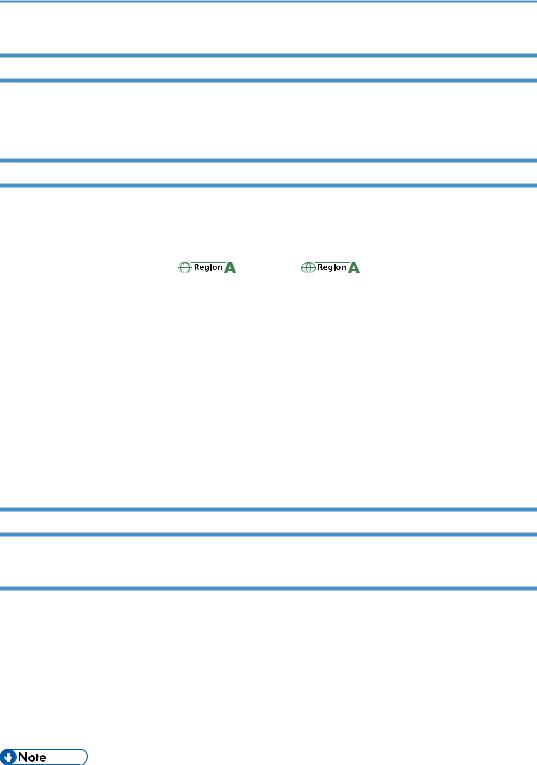
About IP Address
In this manual, "IP address" covers both IPv4 and IPv6 environments. Read the instructions that are relevant to the environment you are using.
Differences in Performance/Functions between Different Models
The differences in main performance/functions between different models are as follows:
|
|
SP 211 |
|
SP 213w |
|
||
|
|
|
(mainly |
|
|
(mainly |
SP 213Nw |
|
|
|
|
||||
|
|
Europe and Asia) |
|
Europe and Asia) |
|
||
|
|
|
|
|
|
|
|
Type |
|
Type 1 |
|
Type 2 |
Type 3 |
||
|
|
|
|
|
|
||
PCL driver |
|
Not available |
|
Available |
Available |
||
|
|
|
|
|
|
||
GDI driver |
|
Available |
|
Not available |
Not available |
||
|
|
|
|
|
|
||
Ethernet Port (Network) |
|
Not available |
|
Not available |
Available |
||
|
|
|
|
|
|
||
Wireless LAN |
|
Not available |
|
Available |
Available |
||
|
|
|
|
|
|
||
Web Image Monitor |
|
Not available |
|
Available |
Available |
||
|
|
|
|
|
|
|
|
Note to Administrator
Password
Certain configurations of this machine can be password-protected to prevent unauthorized modifications by others. We strongly recommend you to create your own password immediately.
The following are the operations that can be password-protected:
•Configuring the [System Settings], [Network Settings], [IPsec Settings], or [Administrator Tools] menu using Web Image Monitor
By default, the access to the machine via Web Image Monitor is not password-protected. The setting for configuring the password can be found in [Administrator Settings].
•For details about setting a password, see page 57 "Configuring the Administrator Settings".
5

Model-Specific Information
This section explains how you can identify the region your machine belongs to.
There is a label on the rear of the machine, located in the position shown below. The label contains details that identify the region your machine belongs to. Read the label.
DCT065 |
The following information is region-specific. Read the information under the symbol that corresponds to the region of your machine.




 (mainly Europe and Asia)
(mainly Europe and Asia)
If the label contains the following, your machine is a region A model:
•CODE XXXX -27, -29
•220-240V




 (mainly North America)
(mainly North America)
If the label contains the following, your machine is a region B model:
•CODE XXXX -17
•120V
•Dimensions in this manual are given in two units of measure: metric and inch. If your machine is a Region A model, refer to the metric units. If your machine is a Region B model, refer to the inch units.
6
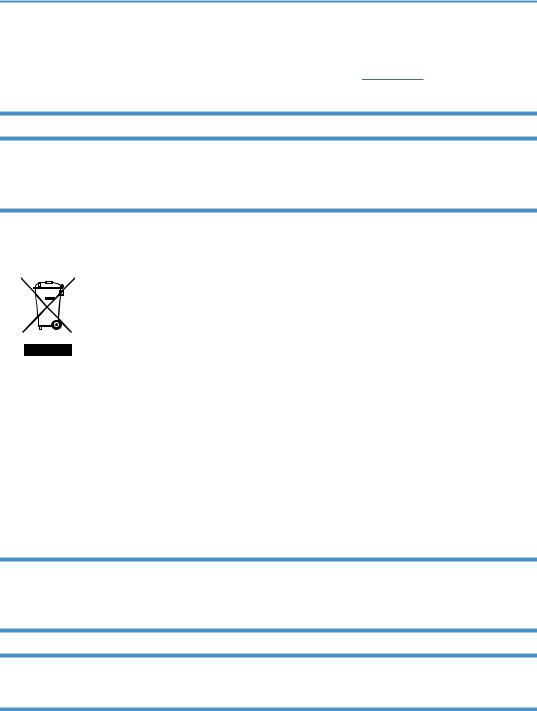
Important Safety Instructions 





User Information on Electrical & Electronic Equipment
Users in the countries where this symbol shown in this section has been specified in national law on collection and treatment of E-waste
Our Products contain high quality components and are designed to facilitate recycling. Our products or product packaging are marked with the symbol below.
The symbol indicates that the product must not be treated as municipal waste. It must be disposed of separately via the appropriate return and collection systems available. By following these instructions you ensure that this product is treated correctly and help to reduce potential impacts on the environment and human health, which could otherwise result from inappropriate handling. Recycling of products helps to conserve natural resources and protect the environment.
For more detailed information on collection and recycling systems for this product, please contact the shop where you purchased it, your local dealer or sales/service representatives.
All Other Users
If you wish to discard this product, please contact your local authorities, the shop where you bought this product, your local dealer or sales/service representatives.
Environmental Advice for Users
Users in the EU, Switzerland and Norway
Consumables yield
Please refer to either the User’s Manual for this information or the packaging of the consumable.
Recycled paper
The machine can use recycled paper which is produced in accordance with European standard EN 12281:2002 or DIN 19309. For products using EP printing technology, the machine can print
7

on 64g/m2 paper, which contains less raw materials and represents a significant resource reduction.
Duplex printing (if applicable)
Duplex printing enables both sides of a sheet of paper to be used. This saves paper and reduces the size of printed documents so that fewer sheets are used. We recommend that this feature is enabled whenever you print.
Toner and ink cartridge return program
Toner and ink cartridge for recycling will be accepted free of charge from users in accordance with local regulations.
For details about the return program, please refer to the Web page below or consult your service person.
https://www.ricoh-return.com/
Energy efficiency
The amount of electricity a machine consumes depends as much on its specifications as it does on the way you use it. The machine is designed to allow you to reduce electricity costs by switching to Ready mode after it prints the last page. If required, it can immediately print again from this mode.
If no additional prints are required and a specified period of time passes, the device switches to an energy saving mode.
In these modes, the machine consumes less power (watts). If the machine is to print again, it needs a little longer to return from an energy saving mode than from Ready mode.
For maximum energy savings, we recommend that the default setting for power management is used.
Products that comply with the Energy Star requirement are always energy efficient.
Note for the Battery and/or Accumulator Symbol (For EU countries only)
In accordance with the Battery Directive 2006/66/EC Article 20 Information for end-users Annex II, the above symbol is printed on batteries and accumulators.
This symbol means that in the European Union, used batteries and accumulators should be disposed of separately from your household waste.
In the EU, there are separate collection systems for not only used electrical and electronic products but also batteries and accumulators.
Please dispose of them correctly at your local community waste collection/recycling centre.
8

Important Safety Instructions 





Notes to Users in the State of California
Perchlorate Material - special handling may apply. See: www.dtsc.ca.gov/hazardouswaste/ perchlorate
9

10
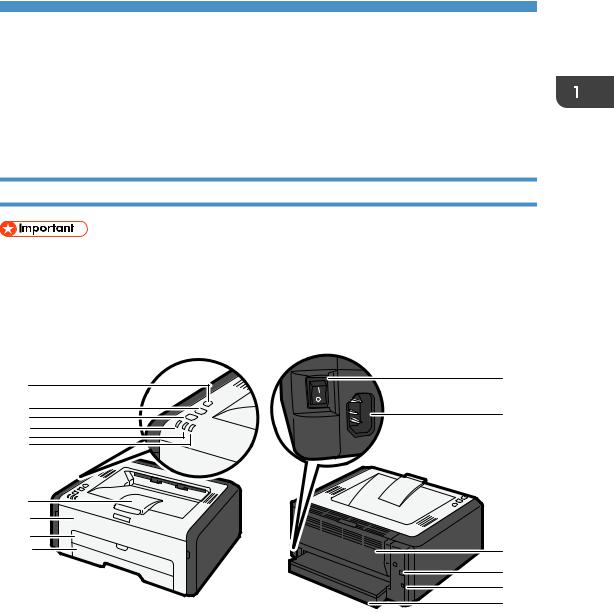
1. Guide to the Machine
Guide to Components
This section introduces the names of the various parts on the front and rear side of the machine and outlines their functions.
Exterior
•Type 1 and 2 models do not come with an Ethernet port.
•Type 1 models do not have the [Wi-Fi] key.
•Only Type 2 and 3 models can print the test page using the [Job Reset] key.
1 |
11 |
|
|
2 |
12 |
3 |
|
4 |
|
5 |
|
6 |
|
7 |
|
8 |
|
9 |
|
10 |
13 |
|
14 |
|
15 |
|
16 |
|
DCT831 |
1.[Wi-Fi] key
To switch to wireless LAN, press this key.
By holding down the key, you can display the menu for configuring the WPS using the PIN code or when in PBC mode.
2.[Job Reset] key
Press this key to cancel an ongoing print job. You can also print the test page by switching the power on while holding this key down and not releasing the key until 13 seconds have elapsed.
11

1.Guide to the Machine
3.[Stop/Start] key
You can use this key to print on the back of paper in duplex printing and to execute forced printing.
You can also print the configuration page or maintenance page by switching the power on while holding this key down and not releasing the key until 13 seconds have elapsed. The maintenance page is printed with Type 1 model and the configuration page is printed with Type 2 or Type 3 model.
4.Power Indicator
This indicator lights up blue when the machine is turned on. It flashes when a print job is received and while printing is in progress.
5.Alert Indicator
This indicator flashes in red if the paper jams, and lights continuously if another error occurs.
6.Toner/Paper End Indicator
This indicator flashes red when the toner is nearly empty, and it lights up when the machine runs out of paper or toner and when the toner is not set correctly.
7.Stop Fences
Raise this fence to prevent paper from falling off.
8.Front Cover
Open this cover to replace consumables or clear a paper jam.
9.Bypass Tray
This tray can hold one sheet of plain paper.
10.Tray 1
This tray can hold up to 150 sheets of plain paper.
11.Power Switch
Use this switch to turn the power on or off.
12.Power Connector
Connect the power cord to the machine here. Insert the other end of the cable into a nearby wall outlet.
13.Rear Cover
Open this cover to deliver sheets face up or remove jammed paper.
14.USB Port
Use this port to connect the machine to a computer using a USB cable.
15.Ethernet Port
Use this port to connect the machine to a network using a network cable.
16.Tray Cover
Attach this cover when you extend the tray.
12

Guide to Components
Interior
1
DCT064
1.Print Cartridge
A replacement consumable that is required to make prints on paper. For details about replacing the cartridge, see page 65 "Replacing the Print Cartridge".
13

1. Guide to the Machine
About Operation Tools
This section explains the operation tools of this machine.
•Depending on the model, Web Image Monitor may not be available. For details about modelspecific differences, see page 5 "Differences in Performance/Functions between Different Models".
Smart Organizing Monitor
Install this utility on your computer from the included CD-ROM before using it. Using Smart Organizing Monitor, you can check the machine's status, configure its settings, and use other functions. For details about how to use Smart Organizing Monitor, see page 60 "Using Smart Organizing Monitor".
Web Image Monitor
You can check the machine's status and configure its settings by accessing the machine via Web Image Monitor. For details about how to use Web Image Monitor, see page 37 "Using Web Image Monitor".
14
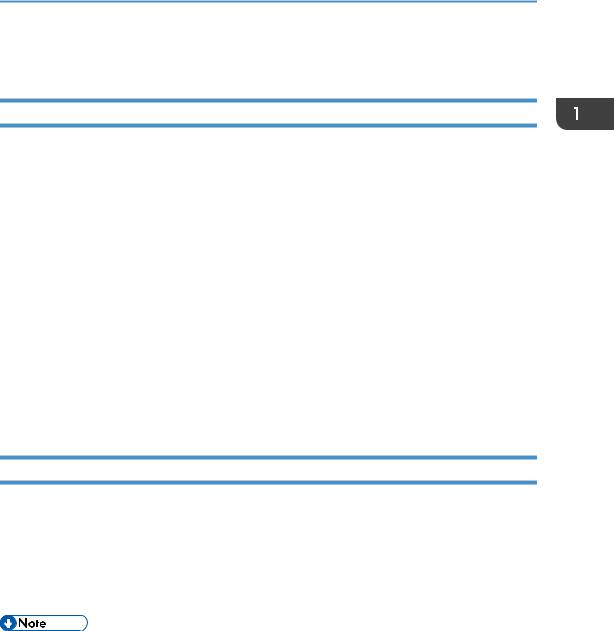
Installing the Driver and Software
Installing the Driver and Software
Network Quick Install
1.Turn on the power of the computer.
2.Insert the CD-ROM into the CD-ROM drive.
3.Select a language and product for the interface, and then click [OK].
4.Click [Network Quick Install].
5.Read the entire license agreement carefully. If you accept its terms, click [I accept the agreement.], and then click [Next >].
6.Select [Add a new printer], and then click [Next>].
7.Select the printer detection method, and then click [Next>].
To search for printers automatically, select [Search for printers automatically].
To search for a printer by its IP address, select [Search for printers by specified IP Address].
To select a port or specify a new port, select [Select a port or specify a new port]. If a dialog box for selecting the port type appears, it is recommended to select the standard TCP/IP port.
8.Follow the instructions in the installation wizard.
Smart Organizing Monitor
1.Turn on the power of the computer.
2.Insert the CD-ROM into the CD-ROM drive.
3.Select a language and product for the interface, and then click [OK].
4.Click [Smart Organizing Monitor].
5.Follow the instructions in the installation wizard.
• For information about USB Quick Install, see the Setup Guide.
15
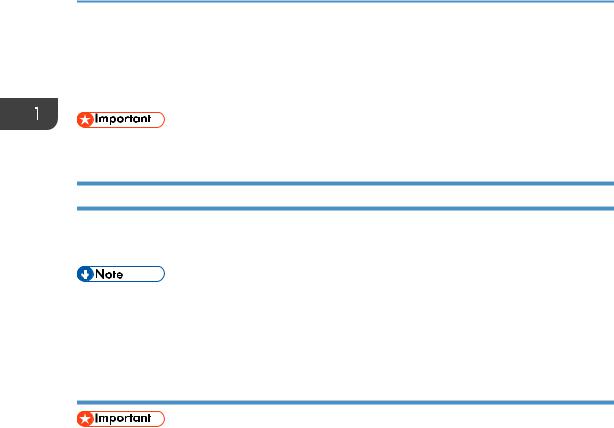
1. Guide to the Machine
Configuring Network Settings
This section explains how to configure network settings.
• Ethernet and wireless LAN settings cannot be enabled at the same time.
Configuring the IP Address Settings Using the Smart Organizing Monitor
The procedure for configuring network settings differs depending on whether IP address information is assigned automatically by the network (DHCP), or manually.
•For details about configuring the IPv4 address, see the Setup Guide.
•For details about printing the configuration page, see page 60 "Using Smart Organizing Monitor".
Specifying settings to receive an IPv6 address automatically
•A DHCP server is required on the network for the machine to receive an IPv6 address automatically.
1.On the [Start] menu, click [All Programs].
2.Click [Smart Organizing Monitor for SP xxx Series].
3.Click [Smart Organizing Monitor Status].
If the machine you are using is not selected, click [Connect Printer], and then select the machine's model.
4.Click the [User Tools] tab.
5.Click [Printer Configuration].
6.Enter the access code, and then click [OK].
The default access code is "Admin". Enter "Admin" if it has not been changed. Case is significant.
7.Click the [IPv6] tab.
8.Select [Enable] in [IPv6 DHCP:].
9.Select [Enable] in [IPv6:], and the click [OK].
10.Click [Close].
16
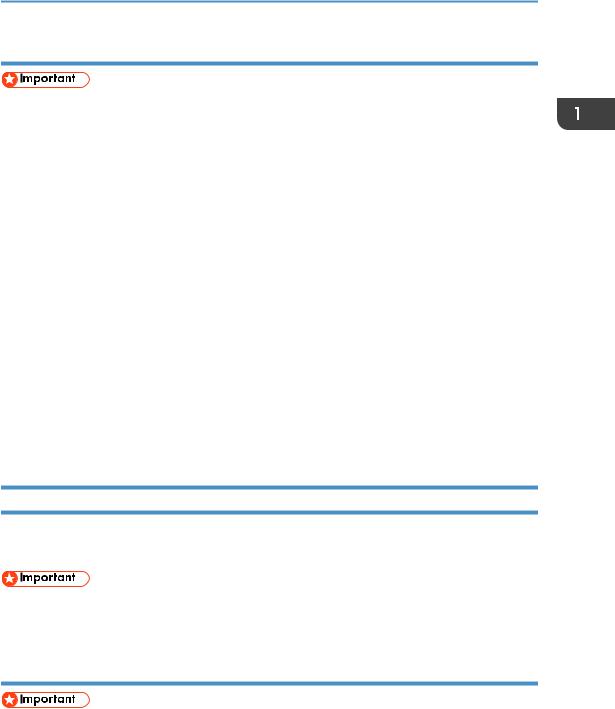
Configuring Network Settings
Assigning the machine's IPv6 address manually
•The IPv6 address assigned to the machine must not be used by any other device on the same network.
1.On the [Start] menu, click [All Programs].
2.Click [Smart Organizing Monitor for SP xxx Series].
3.Click [Smart Organizing Monitor Status].
If the machine you are using is not selected, click [Connect Printer], and then select the machine's model.
4.Click the [User Tools] tab.
5.Click [Printer Configuration].
6.Enter the access code, and then click [OK].
The default access code is "Admin". Enter "Admin" if it has not been changed. Case is significant.
7.Click the [IPv6] tab.
8.Select [Disable] in [IPv6 DHCP:].
9.Select [Enable] in [IPv6:].
10.Enter values in [Manual address:], [Prefix length:], and [Gateway:], and then click [OK].
11.Click [Close].
Wireless LAN Setup
This section explains how to configure the wireless LAN settings manually using Smart Organizing
Monitor. For easy setup using WPS (Wi-Fi Protected Setup), see Wi-Fi Settings Guide.
•If DHCP is enabled, specify the wireless LAN settings over a wired connection, and then reestablish the connection using the wireless IP address.
Configuring the Infrastructure mode using Smart Organizing Monitor
•Ensure that the router, access point, or device equipped with a wireless LAN, etc., is turned on.
•Check the authentication method and the name of the router, access point, or device equipped with a wireless LAN (SSID/IBSS) in advance.
1. On the [Start] menu, click [All Programs].
17

1.Guide to the Machine
2.Click [Smart Organizing Monitor for SP xxx Series].
3.Click [Smart Organizing Monitor Status].
If the machine you are using is not selected, click [Connect Printer], and then select the machine's model.
4.Click the [User Tools] tab.
5.Click [Printer Configuration].
6.Enter the access code, and then click [OK].
The default access code is "Admin". Enter "Admin" if it has not been changed. Case is significant.
7.On the [Network 1] tab, set [Wireless Function:] to [Active].
8.On the [Wireless] tab, set [Manual Setup] to [Configuration Method].
9.In [SSID], enter the SSID in [Wireless LAN Setting].
10.Set [Communication Mode] to [Infrastructure].
11.In the [Authentication] box, select the authentication method.
12.In the [Encryption] box, select the encryption method.
If you have selected [WPA2-PSK] or [Mix Mode WPA/WPA2] in [Authentication], proceed to Step 17.
13.In the [WEP Key Length] box, select [64 bit] or [128 bit].
14.In the [WEP Transmit Key ID] box, select the ID.
15.In the [WEP Key Format] box, select [Hexadecimal] or [ASCII].
16.In [WEP Key], enter the password.
If you have specified [WEP key], proceed to Step 18.
17.In [WPA Passphrase], enter the password.
18.Click [OK].
19.Click [Close].
20.Press the [Wi-Fi] key.
21.Check the result. Connection has succeeded:
The [Wi-Fi] key changes from flashing to continuous lighting.
Connection has failed:
The alert indicators start flashing, then, after 30 seconds, the alert indicator goes out and the power indicator lights continuously.
18

Configuring Network Settings
Configuring the Ad hoc mode using Smart Organizing Monitor
•In Ad Hoc network, every device must be manually assigned an IP address for TCP/IP if there is no DHCP server.
•In Ad Hoc mode, only Open System or WEP encryption is supported. WPA2-PSK and Mix Mode WPA2/WPA authentication methods are not supported.
1.On the [Start] menu, click [All Programs].
2.Click [Smart Organizing Monitor for SP xxx Series].
3.Click [Smart Organizing Monitor Status].
If the machine you are using is not selected, click [Connect Printer], and then select the machine's model.
4.Click the [User Tools] tab.
5.Click [Printer Configuration].
6.Enter the access code, and then click [OK].
The default access code is "Admin". Enter "Admin" if it has not been changed. Case is significant.
7.On the [Network 1] tab, set [Wireless Function:] to [Active].
8.On the [Wireless] tab, set [Manual Setup] to [Configuration Method].
9.In [SSID], enter the SSID in [Wireless LAN Setting].
10.Set [Communication Mode] to [Ad-Hoc].
11.In the [Ad-Hoc Channel] box, select the channel number.
12.In the [Authentication] box, select the authentication method.
13.In the [Encryption] box, select the encryption method.
14.In the [WEP Key Length] box, select [64 bit] or [128 bit].
15.In the [WEP Transmit Key ID] box, select the ID.
16.In the [WEP Key Format] box, select [Hexadecimal] or [ASCII].
17.In [WEP Key], enter the password.
18.Click [OK].
19.Click [Close].
20.Press the [Wi-Fi] key.
21.Check the result. Connection has succeeded:
The [Wi-Fi] key changes from flashing to continuous lighting.
19

1. Guide to the Machine
Connection has failed:
The alert indicators start flashing, then, after 30 seconds, the alert indicator goes out and the power indicator lights continuously.
•For details about how to use Smart Organizing Monitor, see page 60 "Using Smart Organizing Monitor".
20

2. Loading Paper
Supported Paper
Paper Size
•A4
•81/2 " × 11 " (Letter)
•81/2 " × 14 " (Legal)
•B5 JIS
•51/2 " × 81/2 " (Half Letter)
•71/4 " × 101/2 " (Executive)
•A5
•A6
•B6 JIS
•16K (197 × 273 mm)
•16K (195 × 270 mm)
•16K (184 × 260 mm)
•Custom Size
The following paper sizes are supported as custom paper sizes:
•Horiz
Tray1: Approximately 100-216 mm (3.9-8.5 inches) Bypass Tray: Approximately 90-216 mm (3.6-8.5 inches)
•Vert
Approximately 148-356 mm (5.8-14 inches)
Paper Type
•Plain Paper (65-99 g/m2 (17-26 lb.))
•Recycled Paper (75-90 g/m2 (20-24 lb.))
•Thin Paper (52-64 g/m2 (14-17 lb.))
•Thick Paper (100-130 g/m2 (26.6-34 lb.))
Paper Capacity
•Tray1 150 sheets
(70 g/m2, 19 lb.)
21

2.Loading Paper
•Bypass Tray 1 sheet
(70 g/m2, 19 lb.)
22
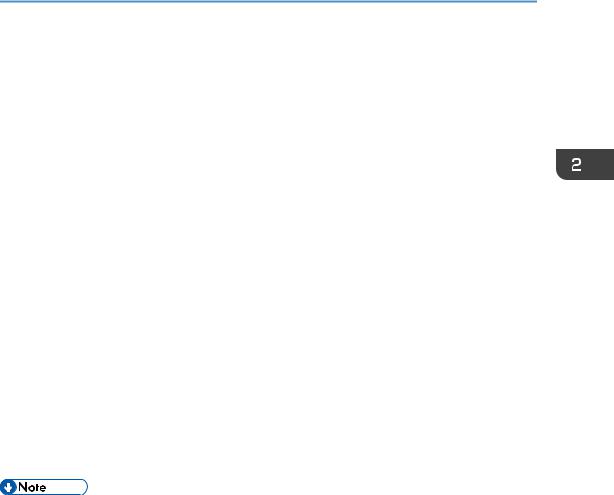
Non-Recommended Paper Types
Non-Recommended Paper Types
Do not use the following types of paper:
•Ink-jet printer paper
•GelJet special paper
•Bent, folded, or creased paper
•Curled or twisted paper
•Wrinkled paper
•Damp paper
•Dirty or damaged paper
•Paper that is dry enough to emit static electricity
•Paper that has already been printed onto, except a preprinted letterhead paper.
Malfunctions are especially likely when using paper printed on by other than a laser printer (e.g. monochrome and color copiers, ink-jet printers, etc.)
•Special paper, such as thermal paper and carbon paper
•Paper weighing heavier or lighter than the limit
•Paper with windows, holes, perforations, cutouts, or embossing
•Adhesive label paper on which glue or base paper is exposed
•Paper with clips or staples
•When loading paper, take care not to touch the surface of the paper.
•Even if paper is adequate for the machine, poorly stored paper can cause paper misfeeds, print quality degradation, or malfunctions.
23
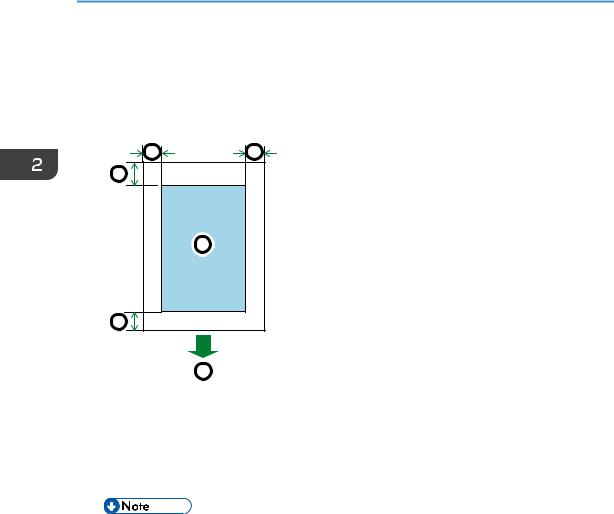
2. Loading Paper
Print Area
The diagram below shows the area of the paper that the machine can print on.
From the printer driver
4 |
4 |
3
1
3
2
CHZ904
1.Print area
2.Feed direction
3.Approx. 4.2 mm (0.2 inches)
4.Approx. 4.2 mm (0.2 inches)
•The print area may vary depending on the paper size and printer driver settings.
•To adjust the print position, specify [Registration: Tray 1] or [Registration: Bypass Tray] on the
[Maintenance] tab in Smart Organizing Monitor.
24
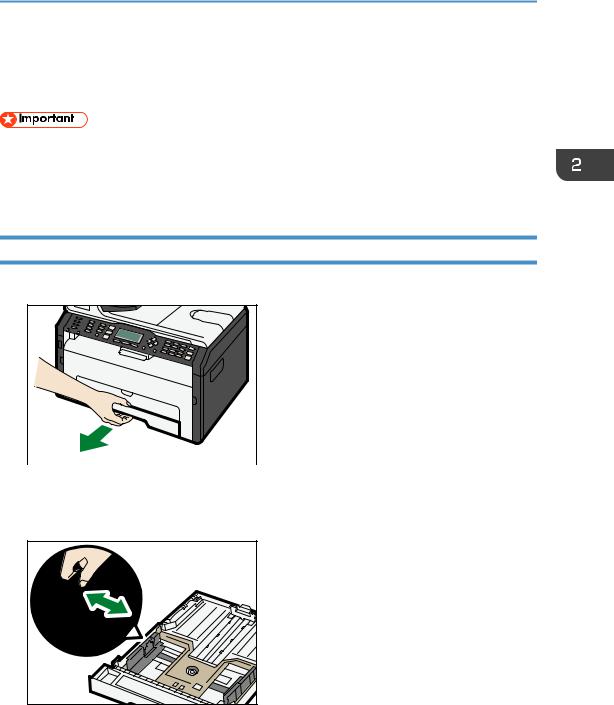
Loading Paper
Loading Paper
Load a stack of paper for printing in the input tray.
•When loading paper, be sure to configure the paper size and paper type for the bypass tray and Tray 1. When printing a document, specify the paper size and paper type and select the paper tray in the printer driver so that the settings configured when paper is loaded can be used for printing.
Loading Paper into Tray 1
1. Pull Tray 1 out slowly, and then remove it using both hands.
DCT063 |
Place the tray on a flat surface.
2. Pinch the clips on the side paper guides and slide them to match the standard size.
DCT030 |
25
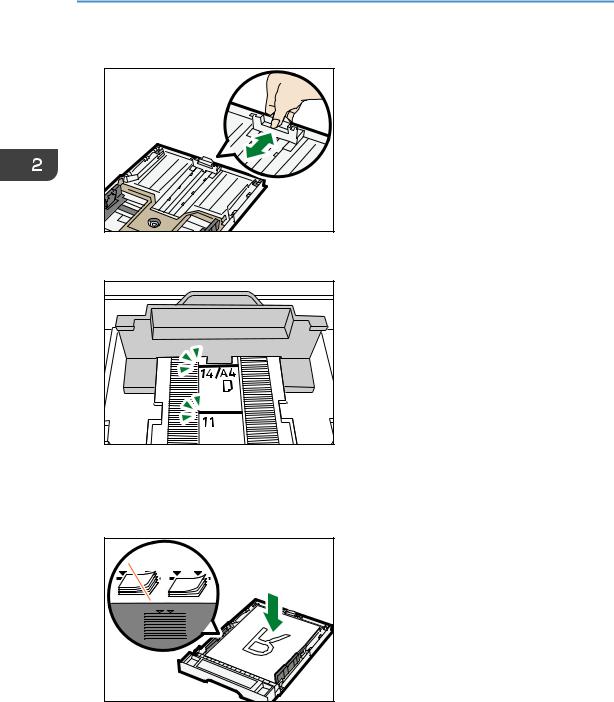
2.Loading Paper
3.Pinch the end paper guide and slide it inward to match the standard size.
DCT031 |
When loading A4 or letter size paper, align the paper guide to the following position:
DCT871 |
4.Fan the paper before loading it in the tray.
5.Load the new paper stack print side down.
Make sure paper is not stacked higher than the upper limit marked inside the tray.
DCT032 |
26
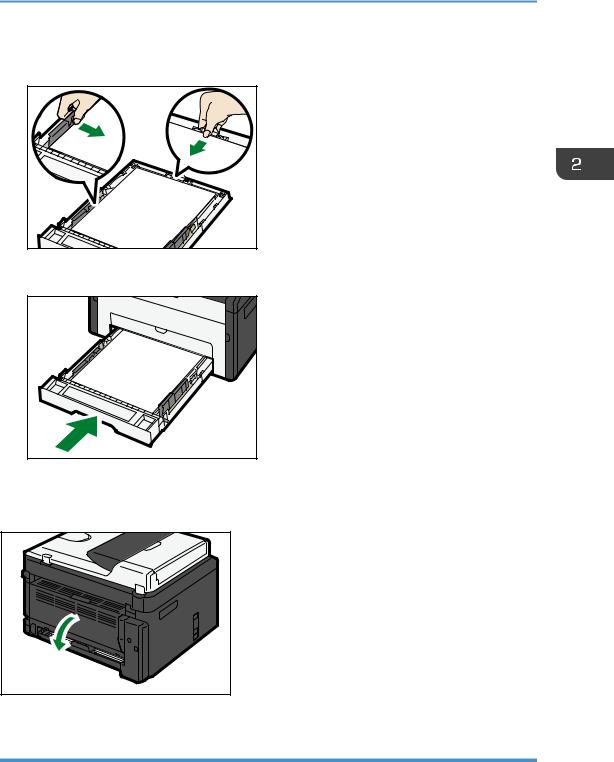
Loading Paper
6.Check there are no gaps between the paper and the paper guides (both side and end paper guides).
DCT049 |
7. Carefully push Tray 1 straight into the machine.
DCT011 |
To avoid paper jams, make sure the tray is securely inserted.
To deliver the sheets face up, open the rear cover.
DCT037 |
Extending Tray 1 to load paper
1. Pull Tray 1 out slowly, and then remove it using both hands.
27
